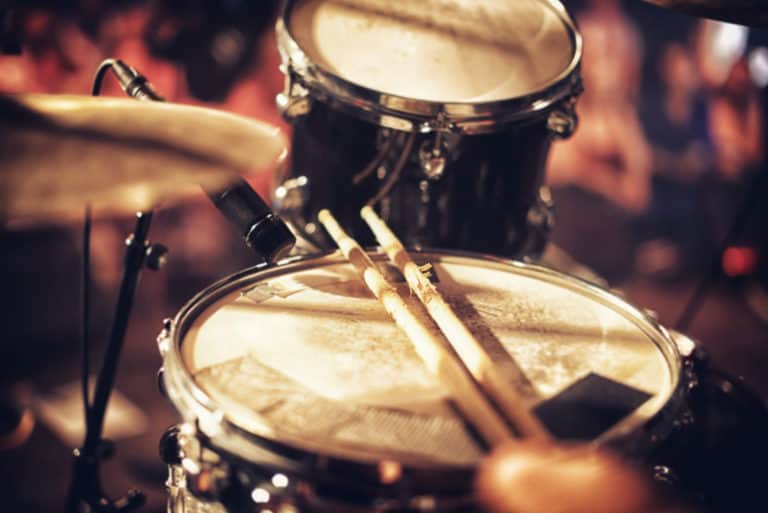How Do Drums Make Sound?
Drums have been a part of cultures around the world for thousands of years. While they have served in different capacities over the years, from communication and warfare to entertainment, not many people understand the mechanics behind how drums produce sound. So, how do they make sounds?
Drums make sound by vibrating when struck by hand, padded mallet, or drum stick. The head of the drum (skin) vibrates up and down with each hit, pushing the air molecules around it and creating air pressure differentials that our ears perceive as sound.
There’s substantial science behind how drums make sound and a couple of factors that affect how a drum sounds. In this article, we’ll break down the basic anatomy of the drum and the different parts that make it sound unique.
The Anatomy of a Drum
A drum is a versatile instrument that can be used in many ways and for different audiences. Various drums are used for different styles of music, and the same drum can be played in very different ways.
Perhaps the most important determinant of any drum’s sound is its anatomy. The different parts, shapes, and designs determine how this instrument will sound, as you will see later in the article. And while all drums have unique characteristics, they also share some common traits that give them their particular sounds.
Parts of a Drum
- The drum head – The drumhead is the part you strike with the drumstick. It is the topmost component of any drum and can be made from various animal skins (sheepskin, goat skin, and cowhide). The drum head can also be made with synthetic materials (e.g., polyester, Kevlar, or Mylar) and is responsible for the vibrations that make the sound.
- The shell – The shell is the main body of the drum. It’s usually made of wood and is responsible for the drum’s resonance and sustain. The material used (wood, aluminum, or steel, for example) and how it is shaped and formed will affect the drum’s sound.
- Drum rim – The drum rim (also known as the drum hoop) is a circular piece of wood, metal, or occasionally other materials that attach to your drum’s top. It holds the drumhead in place and provides the tension needed to produce different tones in your drum beats.
- Tuning keys – Like a guitar, the drum can be tuned to produce a higher or lower tone by tightening or loosening the drumhead. A drum’s tuning keys are small metal structures that help you tighten the head and achieve the perfect tone.
- Drum pedal – A pedal is an accessory that attaches to the base of the drum kit. A drummer steps on the pedal to hit the bass drum, matching the song’s beat.
The Mechanics of Sound Production in a Drum
Having covered the various parts of a drum, let’s zero in on what happens inside it to create sound.
Sound is vibration. It is a mechanical wave created by a disturbance in an elastic medium and transferred into the air around us. Drums and other musical instruments, like the guitar and the harp, make sound thanks to vibrations.
When you hit the drum head, the skin vibrates, rapidly compressing and expanding the air under and above it. This quick expansion and compression of air creates rapid changes in air pressure. It’s from these air pressure changes that sound waves are born. The waves then travel through the air until your ear picks them up as sound from your drum.
Like many other instruments, drums are designed to play a particular range of notes. This depends on the size of the drum and the material it’s made from. The notes that a drum can make are also determined by the size of the shell, what it’s made of, and the thickness and tension of the drumhead.
Drum Shapes, Size, Thickness, and How They Affect Sound
As mentioned earlier, a drum’s sound is shaped by the type of shell, its dimensions, the material it’s made of, and how it’s tuned. Each of these elements has a unique effect on how the drum sounds. And while most (if not all drums) have a rounded shell, their size plays the most crucial role in their sound.
Shell Size
Bigger drums produce lower tones. It all goes back to the size of the skin and shell. Bigger drums have large skins that vibrate less. On the other hand, smaller drums have smaller skins that vibrate more times per second, giving off a higher-pitched attack sound when struck. That’s why a 20″ x 14″ bass drum will produce a lower frequency beat and more ‘oomph’ than a 14″ snare drum.
Keep in mind that the shell size also affects the volume of the drum. A larger drum displaces more air and therefore sounds louder. A smaller drum displaces less air but sounds sharper and quieter than a larger drum. In simpler terms, the larger the drum, the louder it sounds.
Shell Material
Although often overlooked, the material of the shell is another primary factor determining the sound of a drum. Different materials produce different tones, which gives you a wide selection to choose from based on the tone you want your drums to have:
- Birch and maple are common drum shell materials. Birch produces a bright, crisp sound, while maple produces a warmer tone.
- Mahogany is another common option; it provides a warmer tone than maple.
- Oak is a more balanced option, with a rich mid-range.
- Metal shells will always produce higher notes.
When choosing a drum shell, keep in mind its impact on the tone of your drums. You might want a drum shell material that works well with certain types of music. You can also purchase shells made from synthetic materials like carbon fiber to get a more focused tone.
Depending on the music you play, you may want a drum with a certain type of shell material.
For example, if you are in a loud rock ‘n’ roll band, you may want to choose a drum with hard shell material, such as maple. On the other hand, someone playing in a quieter acoustic group may want to choose a drum with softer shell material, such as birch.
Thickness
Thinner shells will produce a lower tone, while thicker shells create a higher one. Shell thickness is measured in millimeters, and most shells fall between 5mm and 10mm. If you’re a beginner, I recommend starting with thinner shells because they’re easier to work with. These shells have less material inhibiting vibration, making them easy to vibrate.
Drum Sounds Are Affected by the Technique
The way you hit the drums has a major impact on the sound you get. There are numerous variables to take into account when playing drums, such as where you strike the head, how hard you strike it, what part of your hand hits it, and the angle at which you strike the head. All these affect the sound of the drum.
For example, if you strike the head of the drum from the side at a sharp angle, you’ll get a different tone than if you strike it from the top at a shallow angle. It’s important to experiment with different angles and positions to find the sounds that work best for your music.
Drummers have their own unique styles. Some drummers are heavy and hard-hitting, while others are light and fast with lots of snare work. Drummers use different-sized drumsticks; smaller sticks feel lighter and can be moved effortlessly. Heavier and larger sticks are harder to move fluidly but produce louder sounds with less effort.
Drum Tuning Has an Impact on the Sound Your Drum Produces
The way you tune your drums makes a big difference in their sound. The tension of the head and the position of the drum under the tunable tension rod has a direct impact on the sound. You may also experiment with different materials for the heads to get a different sound.
Drum tension rods increase the responsiveness of the drum by tightening its skin more firmly over its shell. They also help keep the drum at a consistent pitch and volume.
When tuning a drum, you are adjusting the tension on the head to get the desired sound. Depending on your playing style, there’s a sweet spot where the drum sounds its best. You will lose some of the character and volume if you go too far in either direction.
It’s important to keep in mind the type of music you are playing. Depending on the genre, you may want tighter or looser tension on the head.
How To Play Drums and Make Them Sound Better
Any drummer will tell you that the drums are one of the most physically demanding instruments to play. It’s not just about having stamina or rhythm but also strength, agility, and flawless coordination between your arms and feet.
To become a proficient drummer and hit those beats like a pro takes practice, practice, and more practice. Playing the drums involves using your entire body, from your fingers to your legs.
Before we go into the details on how to play the drum, it’s important to point out that you’ll use both hands and feet simultaneously while also remaining stationary. This may seem like a lot to ask of someone who has never played an instrument before, but it is possible to learn how to drum with some practice and patience.
Here are the steps:
1. Get a Solid Drum Kit
The first thing you should do is purchase a solid drum kit. As a beginner, you don’t need to invest in a high-end kit right away. What’s important is to ensure that the kit you purchase is made with quality materials.
Don’t worry; there are plenty of affordable kits out there that are great for beginners. One example is the Donner Drum Set (available on Amazon.com). Other than its visually striking appearance, this beginner/professional drum kit has everything you need to start playing drums, including a high hat, tom, and cymbals. Plus, it comes with mute pads so you can keep the noise down while you practice.
If you’re staring into a long career as a drummer, you’re probably better off with a higher-end model like the PDP By DW 7-Piece Concept Maple Shell Pack (available on Amazon.com). This drum set is perfect for drummers looking for a quality upgrade. It comes with everything you need to start jamming out in your living room or on the stage. The shells are made of basswood for a warm tone that packs a punch.
2. Learn the Basic Drumming Techniques
Learning the basics of drumming is the first step toward becoming a better drummer. The basics of learning how to drum aren’t difficult, but they do require practice. You can start with simple beats and work your way up to more complicated rhythms as your skills improve.
Here are a few basic drumming techniques to get you started:
The Full/Half-Stroke
Full stroke drumming is the process of striking the drum head with one fluid motion. It involves striking the drum head with the drumstick from top to bottom. Check out this video for a more detailed explanation of the full stroke:
The half-stroke technique is somewhat similar to the full-stroke. But instead of hitting the drum and pulling the stick back up, you let it rest 2-3 inches (5.04-7.62 centimeters) above the drum head.
Tap-Up
This technique starts off by hitting the drum from two to three inches above the drum head. Next, pull up the drum stick all the way to the full-stroke position. Check out this video for more detailed instructions about the half-stroke and tap-up drumming techniques:
The Rebound Stroke
To do the rebound stroke, you need to have a drum stick in each hand. Hold the stick between your thumb and index finger. Keep your wrists loose and relaxed, and raise your hand to the full stroke position. Let the drumstick rebound to the original position as you strike the drum.
One key point to remember is that it takes a lot of time and practice before you can perfect your skills.
3. Don’t Forget To Involve Your Feet
Another important aspect of learning how to play the drums that many beginners seem to forget is learning how to use their feet properly. On that note, getting a foot pedal for your bass drum is important. If you do have one, use it to keep the beat alive while you’re playing the snare drums with your hands or soloing with your voice.
4. Practice With a Metronome
The idea of adding a metronome to your setup may sound a little far-fetched, but this little device can actually help you develop a strong, accurate sense of rhythm in your drumming routine.
A metronome is a device that produces an audible click at a set interval, most commonly every second. You can use a metronome to help you keep a steady tempo when practicing. It can be used to help with counting out loud.
Using a metronome in your practice is easy and straightforward:
- Set the device to a slow tempo.
- Try playing simple beats on the drum set to the sound of the metronome.
- As you get more comfortable playing to the metronome’s beat, gradually increase its tempo.
- When you are able to play simple beats at an advanced tempo, you know you’ve reached the next level in your drumming journey.
Also, don’t forget to practice your drum rudiments. Drum rudiments are simple exercises that help you to develop your technique, speed, and accuracy. You can find most of these exercises online or in a drumming book for beginners. It is important to practice these rudiments daily to improve your drumming skills.
Once you have begun practicing your rudiments, make sure to vary the order in which you do them.
5. Start Drumming
Once you have a solid grasp of drum rudiments and exercises, it is time to begin learning how to play some simple beats. You can start off with the snare and advance to a bass drum.
To begin playing the snare drum:
- Learn a simple drum pattern on your drum set.
- Once you have the pattern selected, place your left hand in your preferred snare drum grip.
- Play the simple drum pattern with the right hand while simultaneously playing a continuous single stroke with the left hand on the snare drum.
- Find the right posture. Poor posture makes it much more difficult to control your muscles, which can lead to issues with accuracy and speed when playing.
Once you have a good grasp on the snare drum beat, you can move on to the bass drum beat. Bass drum beats are a little bit different from snare drums since you’ll be using your foot pedal. Also, playing the perfect bass requires that you hit the bass drum in the center region.
Conclusion
Drums are simple yet complex instruments, with each part having a unique effect on the sound. Beyond all that, the way you play and tune each drum is also important in shaping the sound. The type of drum heads you use will have an effect on the sound as well, so there is a lot to think about if you want to get the most out of your drums.







